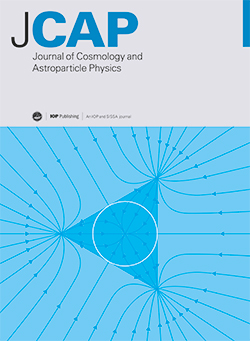用莱曼-α观测结果权衡大质量中微子
IF 5.3
2区 物理与天体物理
Q1 ASTRONOMY & ASTROPHYSICS
Journal of Cosmology and Astroparticle Physics
Pub Date : 2024-09-01
DOI:10.1088/1475-7516/2024/09/003
引用次数: 0
摘要
宇宙学数据尚未揭示大质量中微子的存在。我们在文中考虑采用一种基于高分辨率莱曼-α数据的两点视线相关函数的新方法来实现这一目的。我们采用半解析的莱曼-α云模型进行研究。我们采用费雪矩阵技术证明,有可能实现光谱噪声和信号的两点函数协方差都几乎消失的情况。我们详细分析了这种近乎 "零噪声 "的结果,认为有可能用一条 QSO 视线探测到质量范围 mν ≃ 0.05-0.1 eV 的中微子,信噪比为 1。我们的研究表明,利用红移范围 z ≃ 2-2.5 内的多条视线数据,可以将这一估计值提高到信噪比 ȣ3-6。这类数据集已经存在于文献中。我们进一步对费舍尔矩阵进行了主成分分析,以研究中微子质量与其他参数的退行性。我们发现普朗克先验解除了中微子质量与其他宇宙学参数之间的退行性。然而,中微子质量的探测前景受到莱曼-α云电离和热状态特征参数不确定的影响。我们还提到了使用我们的方法测量中微子质量可能存在的局限性和观测挑战。本文章由计算机程序翻译,如有差异,请以英文原文为准。
Weighing massive neutrinos with Lyman-α observations
The presence of massive neutrinos has still not been revealed by the cosmological data. We consider a novel method based on the two-point line-of-sight correlation function of high-resolution Lyman-α data to achieve this end in the paper. We adopt semi-analytic models of Lyman-α clouds for the study. We employ Fisher matrix technique to show that it is possible to achieve a scenario in which the covariance of the two-point function nearly vanishes for both the spectroscopic noise and the signal. We analyze this near `zero noise' outcome in detail to argue it might be possible to detect neutrinos of mass range mν ≃ 0.05–0.1 eV with signal-to-noise of unity with a single QSO line of sight. We show that this estimate can be improved to SNR ≃ 3–6 with data along multiple line of sights within the redshift range z ≃ 2–2.5. Such data sets already exist in the literature. We further carry out principal component analysis of the Fisher matrix to study the degeneracies of the neutrino mass with other parameters. We show that Planck priors lift the degeneracies between the neutrino mass and other cosmological parameters. However, the prospects of the detection of neutrino mass are driven by the poorly-determined parameters characterizing the ionization and thermal state of Lyman-α clouds. We have also mentioned the possible limitations and observational challenges posed in measuring the neutrino mass using our method.
求助全文
通过发布文献求助,成功后即可免费获取论文全文。
去求助
来源期刊

Journal of Cosmology and Astroparticle Physics
地学天文-天文与天体物理
CiteScore
10.20
自引率
23.40%
发文量
632
审稿时长
1 months
期刊介绍:
Journal of Cosmology and Astroparticle Physics (JCAP) encompasses theoretical, observational and experimental areas as well as computation and simulation. The journal covers the latest developments in the theory of all fundamental interactions and their cosmological implications (e.g. M-theory and cosmology, brane cosmology). JCAP''s coverage also includes topics such as formation, dynamics and clustering of galaxies, pre-galactic star formation, x-ray astronomy, radio astronomy, gravitational lensing, active galactic nuclei, intergalactic and interstellar matter.
 求助内容:
求助内容: 应助结果提醒方式:
应助结果提醒方式:


